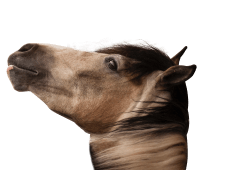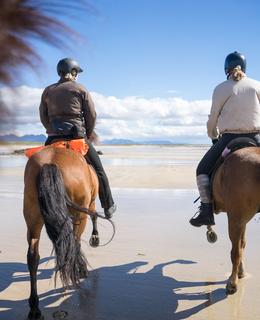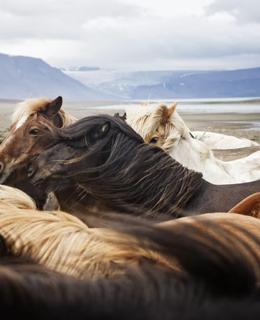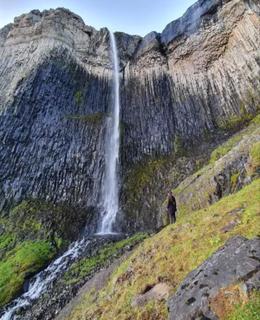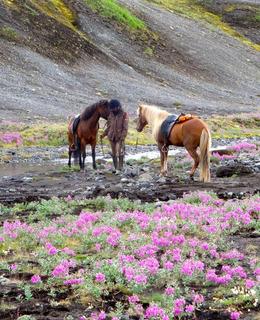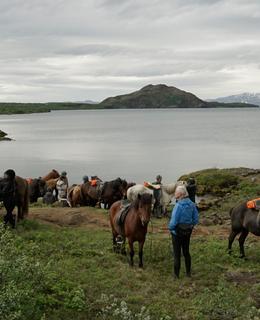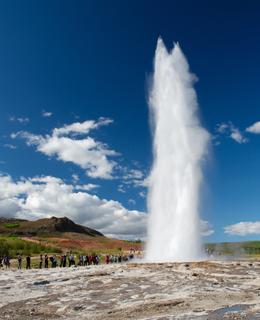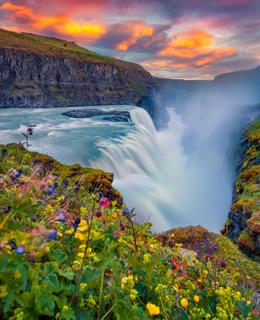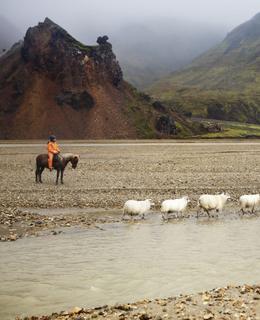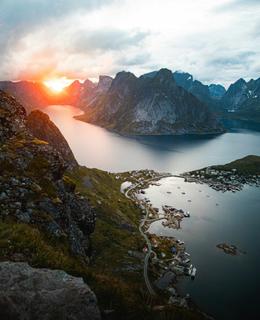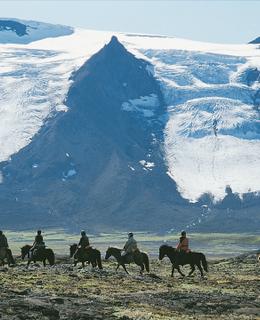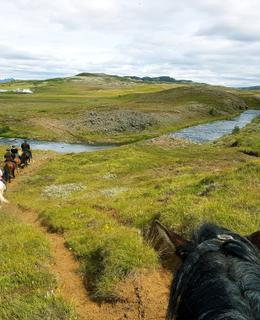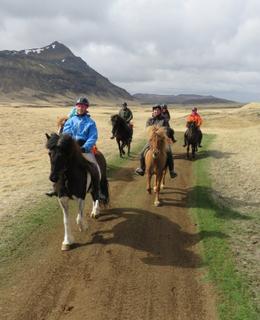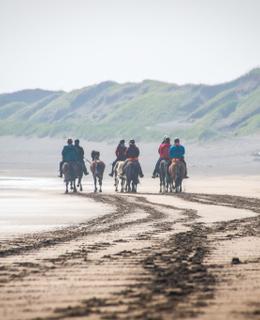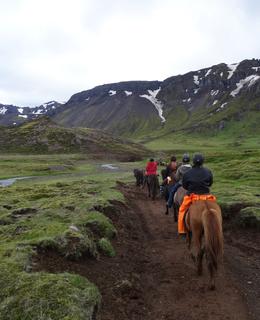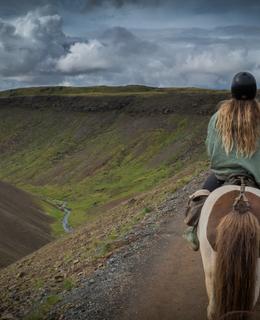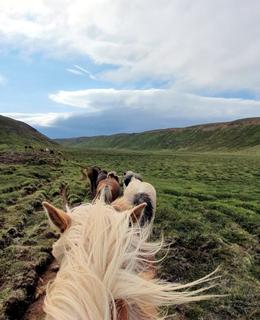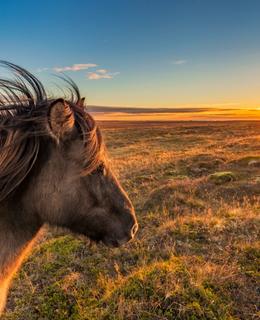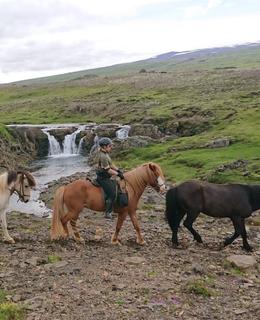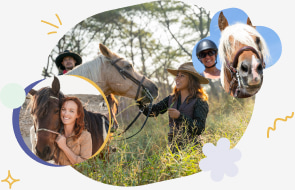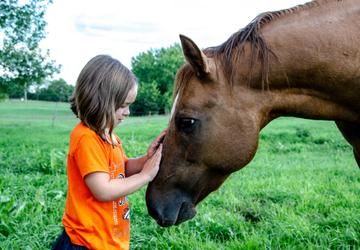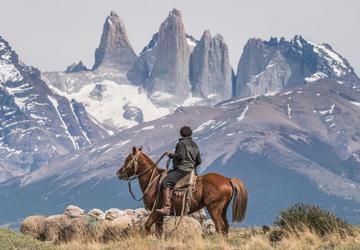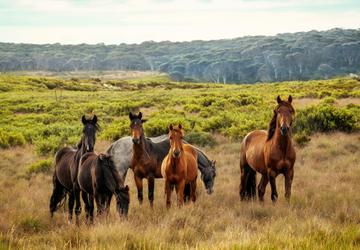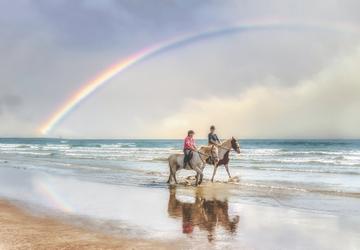Horseback Riding in Iceland
Imagine riding through Iceland’s dramatic landscapes on a gentle, sure-footed Icelandic horse. You might pass roaring waterfalls, extensive lava fields, deep craters, and ancient glaciers.
It’s no wonder Iceland is a top destination for horse riding. This European country is rich in gorgeous landscapes. It beckons visitors with adventure.
Horseback riding tours in Iceland are one of the best ways to see the island nation. On the back of an Icelandic horse, you can explore areas inaccessible on foot or by vehicle. Iceland is full of trails that lead to stunning sites, like the highlands in the north or the Gullfoss Waterfall in the south.
This country is famous for the Icelandic horse, which you’ll be able to get to know when you venture here. This breed is hardy due to the ruggedness of its home, yet these horses have a calm temperament. They have a distinct gait that other horses don’t have, called the tölt, and they are considered one of the purest breeds in the world, as no outside horses are allowed into the country.
Let’s dive into horse riding holidays in Iceland, including why you should visit this country, the types of tours you can experience, the best Iceland horse riding tours and locations, tips for visiting, and FAQs.
Why Choose Horseback Riding in Iceland?
The better question is, why not choose horseback riding in Iceland? But in all seriousness, four main things set Iceland a cut above the rest.
1. Epic Scenery
The views in this country can’t be beat. From black sand beaches to the northern lights to natural hot springs, Iceland is full of beautiful and unique scenery.
On your Icelandic horse holiday, you’ll have the opportunity to explore areas like the Snæfellsnes Peninsula. This region is brimming with incredible sights. Ride along the soft sands of Löngufjörur Beach or see the remnants of an ancient volcano at the Eldborg Crater.
Take a thrilling ride along the Borgarfjörður Fjord, with the sea as your companion on one side and, on the other, a 4-million-year-old mountain called Hafnarfjall. Or explore places like Víðgelmir. At 5,200 feet (1,585 m) long, it’s the largest lava tube in the country.
2. The Icelandic Horse
The original Viking horse, the Icelandic horse is reason enough to visit this country.
These horses have been secluded for over a millennium. It’s said that the first settlers of the island brought only their best horses with them, and so the breed developed from high-quality animals who could survive not only the trip across the sea but also the harshness of the landscape.
Because of the isolation, there are very few diseases on the island. But Icelanders have to be extremely careful about what they let into their country to prevent diseases from coming in. Bringing other horses into the country is prohibited. They don’t even allow used equipment like saddles from outside to come.
Icelandic horses are incredibly versatile. They’re strong, smooth, and intelligent, and they’re known for their calm and gentle nature—perfect for interacting with children, new riders, and other animals. Due to their environment, they are particularly sure-footed, even on rough terrain.
There is one gait the animals are most well-known for: Tölt. It’s a four-beat lateral gait that is very smooth since there are always one or two hooves on the ground. Some Icelandic horses have a fifth natural gait. The flying pace is a two-beat lateral gait that is sometimes used for racing.
3. All Levels of Experience
Between the beginner-friendly Icelandic horse and the variety of trails available on the island, this country is perfect for riders of all levels. Whether you are just starting out or have been riding for decades, you’ll find trails here that fit your needs.
4. Connecting Deeply with Nature
Iceland is one of the least densely populated countries in the world, which means that not only has its natural landscape been preserved, but it is also the perfect place to go to escape from it all.
Here, you can forget your worldly troubles, leave behind technology, and relish the beauty of places off the beaten path. Iceland is the kind of place where you can escape, connect with nature, and experience the natural world.
Types of Tours
Iceland offers a range of tours—everything from short rides to multi-day treks.
Short Rides
Many trails in Iceland only take 1-3 hours, ideal for beginners. On these trails, you can learn the ropes of trail riding and build confidence while still seeing some fantastic sights and not wearing yourself out.
Take the 1.5 Hour Iceland Adventure Ride, for example. This tour explores the amazing Snaefellsnes Peninsula of West Iceland with a family-owned business as your guides. Hear captivating stories about the land and follow your guides through breathtaking, untouched landscapes with a variety of terrain, including roads, lava fields, mud, and sand.
Multi-Day Treks
Multi-day horse riding in Iceland is one of the best ways to truly immerse yourself in this country. With most treks ranging from 5-7 days, you’ll have plenty of time to ride through the wilderness and see all the sights this European country has to offer.
These tours allow you to see some of Iceland’s well-known attractions. On the Geysir Gullfoss Waterfalls Trail, you can visit Thingvellir (Þingvellir) National Park, a UNESCO World Heritage Site, or the Great Geysir, which used to shoot water over 200 feet into the air—both popular attractions in the Golden Circle, which is a common tourist route.
Luxury Riding Holidays
Just because you’re on a horseback riding tour in Iceland doesn’t mean you can’t have premium comfort. Many tours offer accommodations at 4- and 5-star hotels, boutique hotels, or glamping with private pools and beaches, and on-site bars and restaurants.
On a tour of the Mystical Landscapes of Reykjavík, for example, you’ll stay at a hotel on the outskirts of Reykjavík with breathtaking views of the mountains and lake. It’s the perfect place to return to after a day of adventure exploring the area's beautiful scenery.
Seasonal Variations
Summer in Iceland offers pleasant temperatures and long daylight hours, making it the ideal time for Iceland horseback riding vacations. You can venture on paths like the Trail of Hope in Northwest Iceland, where you will visit black sand beaches, rivers, fields, and the gorgeous Lake Hóp underneath the summer sun.
But summer isn’t the only time Iceland shines. If you want to see the Winter Northern Lights, you’ll want to visit sometime between September and April. Uncover the Golden Waterfall, appreciate a famed geothermal area, and experience the serenity of the Icelandic winter.
Top Riding Locations in Iceland
Some of the best horseback riding in Iceland comes in these regions.
South Iceland
The southern area is home to waterfalls, volcanoes, and black sand beaches.
Get The South Iceland Exclusive on a tour that focuses on the region's most scenic trails. Visit the volcanic Thjórsárdalur valley, the unique “horse villages” just outside Reykjavík, and the black lava beaches on the Atlantic coast. The valley of Gjáin awaits with its little ponds and cascades, volcanic structures, and natural treasures—like an oasis in black sand. For this tour, you’ll take the horses in a trailer to travel to a unique area every morning.
North Iceland
North Iceland is characterized by a wide range of landscapes. If you visit this area, you’ll see mountains, fjords, hot springs, lava fields, and volcanic features. It’s also a brilliant location for watching whales.
Sign up for the Fascinating North Iceland tour to participate in an eight-day and seven-night excursion that traces the paths of the gods. Ride with the majestic herd from the Fremstafell, surround yourself with towering trees and vibrant wildlife in the forest of Fellsskógur, and explore the ruins of Stöng, an archaic Viking-era farm.
Golden Circle
A well-known tourist route, the Golden Circle covers about 190 miles (300 km). The route has three top attractions: Þingvellir National Park, Geysir geothermal area, and Gullfoss waterfall.
On the tour of The Golden Circle of Iceland, you’ll get a unique view of these sights and others. Þingvellir (Thingvellir) National Park is a geological and historical pearl. Here, the tectonic plates drift apart, creating a stunning rift valley—no wonder it’s a UNESCO World Heritage Site.
The Geysir hot springs area is home to about 30 geysers and hot pools. The geyser of its namesake has been dormant for years, but another well-known geyser Strokkur erupts regularly, usually reaching 49-66 feet (15-20 m). Sometimes it even reaches 130 feet (40 m).
The “Golden Waterfall,” Gullfoss, is a stunning sight. Every second 100,000 liters of glacial water pour off the cliff and into the Gullfossgljúfur Canyon. Don’t forget a raincoat when you visit this awesome attraction.
Practical Tips & FAQs
Best Time to Visit
Summer is often said to be the best time to visit Iceland. With so many daylight hours, it’s perfect for outdoor activities like horseback riding. However, the aurora borealis is visible during the winter, and it is worth seeing. The time of year you visit depends on the kind of experience you want.
What to Pack
Iceland has a mild climate, but it can get hot or cold, so you’ll definitely want to be prepared as you pack. No matter what time of year, you’ll want to bring layers so you can adapt as the temperature changes.
Here’s a list of some general things you’ll need:
- Breathable and moisture-wicking shirts
- Riding pants or jeans
- Jacket
- Rain jacket
- Boots (broken in)
- Sunglasses
- Sunscreen
- First-aid kit
- Camera
If you plan to bring any riding gear (including riding clothes), be sure to follow Iceland’s regulations on disinfecting it before bringing it into the country. Gear like saddles, bridles, bits, and even riding gloves are prohibited. You will be able to get the equipment you need once you are in the country.
Riding Experience
As mentioned above, Iceland has tours available for all levels of experience. Check each tour to ensure it fits you and your group’s needs.
Safety
Follow these safety tips:
- Be aware of your horse’s actions. Alert your guide if anything seems off.
- Wear safety gear.
- Remain on the trail and adhere to your guide’s instructions.
- Treat your horse kindly. Avoid startling it.
- Keep a safe distance from other riders.
- Pass other riders politely.
Travel Logistics
Most tours include travel to and from the airport, but you are responsible for your own airfare. Some transfers are not included.
Conclusion
You won’t be disappointed by the horse riding holidays in Iceland. You’ll love the Icelandic horse, and lava fields, volcanoes, beaches, mountains, and more await you.
Ready for the ride of a lifetime? Explore our handpicked Icelandic horse riding tours and book your adventure today!


